 vdW clusters
vdW clusters Weakly bound trimers
Weakly bound trimers Resonances
Resonances HCBr
HCBr Insertion reactions
Insertion reactions TD wave packet A+BC
TD wave packet A+BCRESEARCH
 vdW clusters vdW clusters |
 Weakly bound trimers Weakly bound trimers |
 Resonances Resonances |
 HCBr HCBr |
 Insertion reactions Insertion reactions |
 TD wave packet A+BC TD wave packet A+BC |
Photodissociation of van der Waals clusters
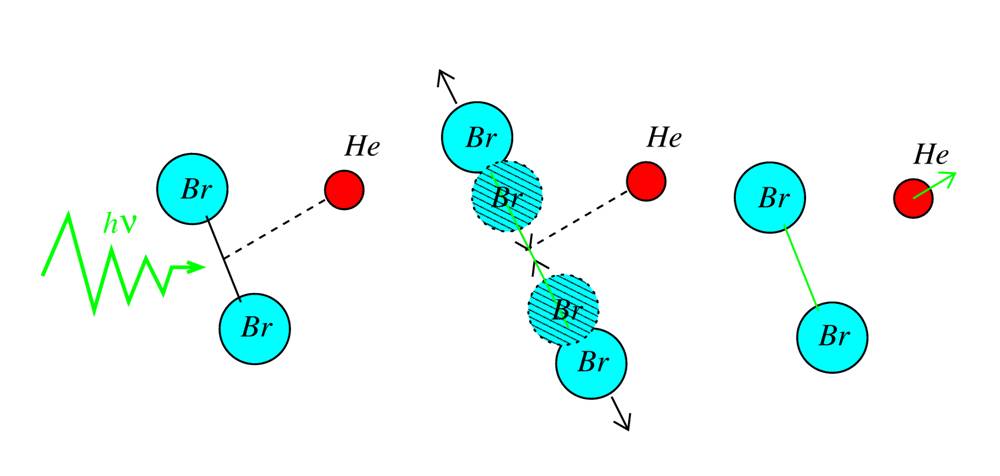 Clusters as HeBr2
are formed by a rare gas atom weakly bound, by means of a vdW bond, to
an halogen diatom. The molecule can be excited† by means of a laser
pulse. The energy absorbed induces a vibrational excitation on the†
Br-Br mode which may be transferred, by means of one or two vibrational
quanta, to the vdW bond He...Br2. This causes the rare gas
atom to be ejected from the complex and thus breaking the trimer.
Clusters as HeBr2
are formed by a rare gas atom weakly bound, by means of a vdW bond, to
an halogen diatom. The molecule can be excited† by means of a laser
pulse. The energy absorbed induces a vibrational excitation on the†
Br-Br mode which may be transferred, by means of one or two vibrational
quanta, to the vdW bond He...Br2. This causes the rare gas
atom to be ejected from the complex and thus breaking the trimer.
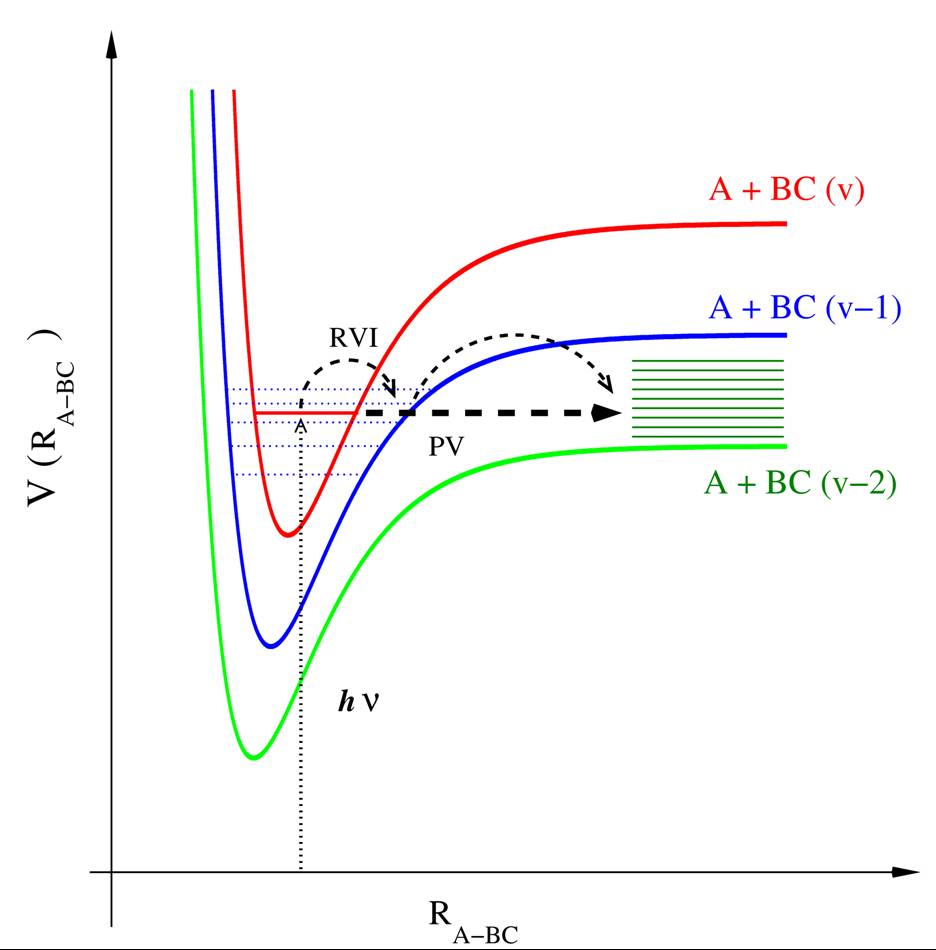 † † † † † † † † † †
† It may happen that if the laser light promotes the system to a high
enough vibrationally excited state v (v > 30),
the transfer of simply one vibrational quantum is not energetically
sufficient to break the vdW bond: the (v-1)
channel is said to be closed . In these situations, the fragmentation
may be the result of two possible mechanisms: on one hand, the two
vibrational quanta required for the dissociation process can be released
sequentially by means of a (v) -> (v-1) and then (v-1)->(v-2) relaxation chain. This is usually called
and internal vibrational redistribution
process. It is possible on the other hand, that the release of the two
quanta was the result of a direct coupling between the (v) and (v-2)
vibrational manifolds.This process is known as a vibrational
predissociation. Part of the interest of the study of
this sort of systems is to elucidate the precise way of fragmentation
since dynamics induced by both mechanisms are sensibly different.
† † † † † † † † † †
† It may happen that if the laser light promotes the system to a high
enough vibrationally excited state v (v > 30),
the transfer of simply one vibrational quantum is not energetically
sufficient to break the vdW bond: the (v-1)
channel is said to be closed . In these situations, the fragmentation
may be the result of two possible mechanisms: on one hand, the two
vibrational quanta required for the dissociation process can be released
sequentially by means of a (v) -> (v-1) and then (v-1)->(v-2) relaxation chain. This is usually called
and internal vibrational redistribution
process. It is possible on the other hand, that the release of the two
quanta was the result of a direct coupling between the (v) and (v-2)
vibrational manifolds.This process is known as a vibrational
predissociation. Part of the interest of the study of
this sort of systems is to elucidate the precise way of fragmentation
since dynamics induced by both mechanisms are sensibly different.
Weakly bound trimers
Among the different special quantum properties of small helium
clusters, the trimers exhibit the so-called Efimov behaviour:
three body systems (3B) formed by two body (2B) subsystems which do not
support bound states (Borromean systems)
or zero-energy resonances may support an infintie number of bound
states when the 2B interactions are strengthened. Furthermore, once a
critical value for the lambda parameter which varies the 2B interactions
is reached, 3B bound states disappear becoming more unstable than the
bound states of one of the 2B subsystems. In Molecular Physics, helium
timers are probably the closest examples to this kind of systems:†
despite He2 dimers do support a bound state, its binding
energy is extremely small (~ -0.9 x 10-3 cm-1),
being the He-He average separation the largest ever experimentally
observed bond distance. †

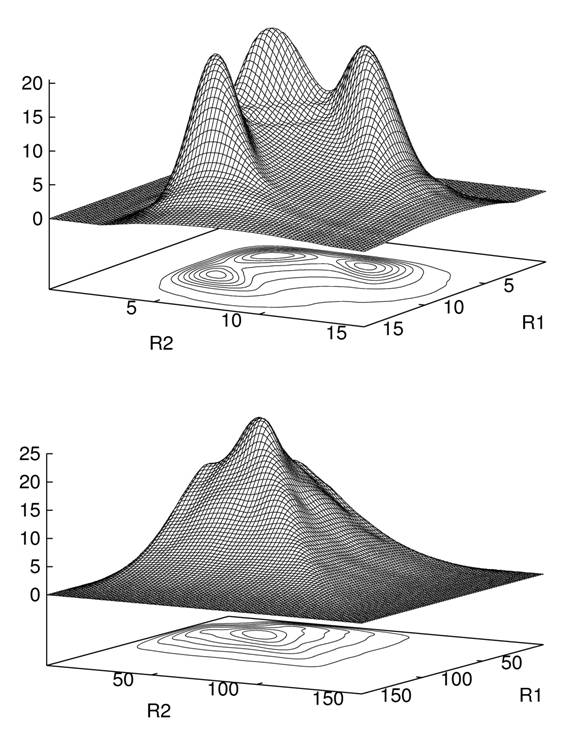
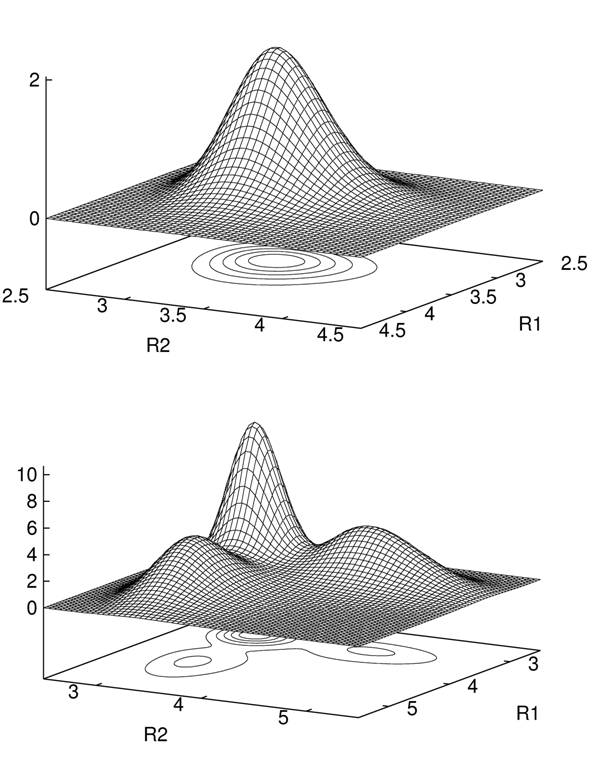
Trimers of this type also present
peculiar characteristics such as a extremely delocalised spatial nature,
weak bonds and some independence with respect to the 2B interaction
potentials. The different spatial extension of the two first bound
states of He trimers with respect to that of the corresponding ground
and first excited state of Ne3 (with a more rigid structure)
is clearly noticeable in the above figures. Combinations of He with
atoms such as Li, H, Na ... are also good candidates to form trimers
with some of these properties.
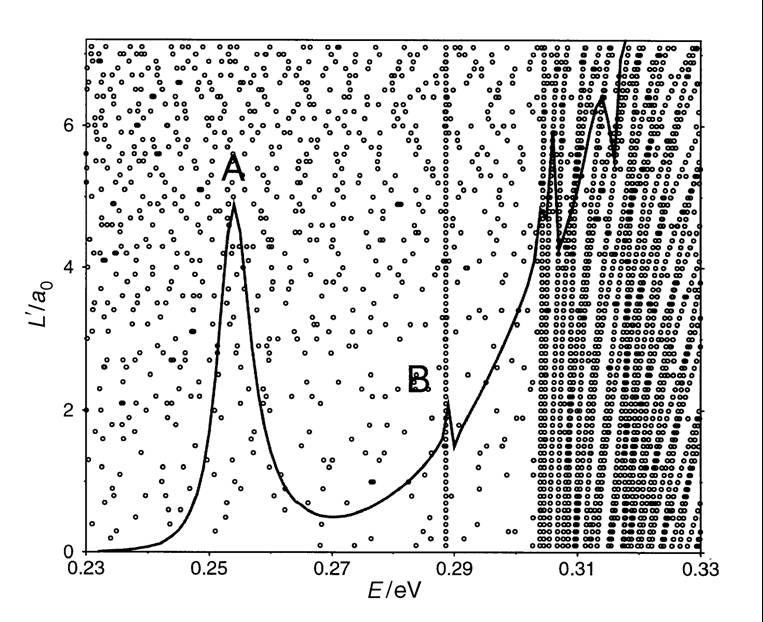

In molecular reactions, resonances may play a crutial role in the process which leads from reactants to products. Sometimes, dynamics of the whole collisional event strongly depend on the existence of resonances associated to the intermediate complex formed in the course of the reaction. Analogously, the phodissociation process of vdW clusters discussed here in the first section, may be influenciated by the existence of resonances on the vibrational manifolds excited by the laser pulse. The characterisation of such resonant states is then crutial to understand the dynamics of the process. By means of theoretical approaches as the stabilization process, useful information concerning these states may be easily gained. Sucessive diagonalizations of the Hamiltonian operator in basis which depend on a single parameter allows the identification of resonant or quasibound states: the energy of such states will behave in a stable manner at some extent with respect to slight variations of that parameter whereas discretizations of continuum states will present a more erratic behaviour. The study of the corresponding wave functions enables on the other hand to assign the corresponding quantum numbers to these resonant states.
A combined experimental and theoretical study of the monobromomethylene
(HCBr) has allowed to obtain rotationally resolved spectra for the
complex formed with both D and H isotopes and the two naturally ocurring
Br isotopes. Characterization for the low-lying bending vibrational
levels in both √ and X states
was also possible. By inclusion of spin-orbit effects between †X 1A' and†√ 1A''
states, the calculated bending vibrational levels in the electronic
ground state reproduce the observations and positions of the triplet and
other singlet state vibronic levels are predicted.
† † † † † † † † †
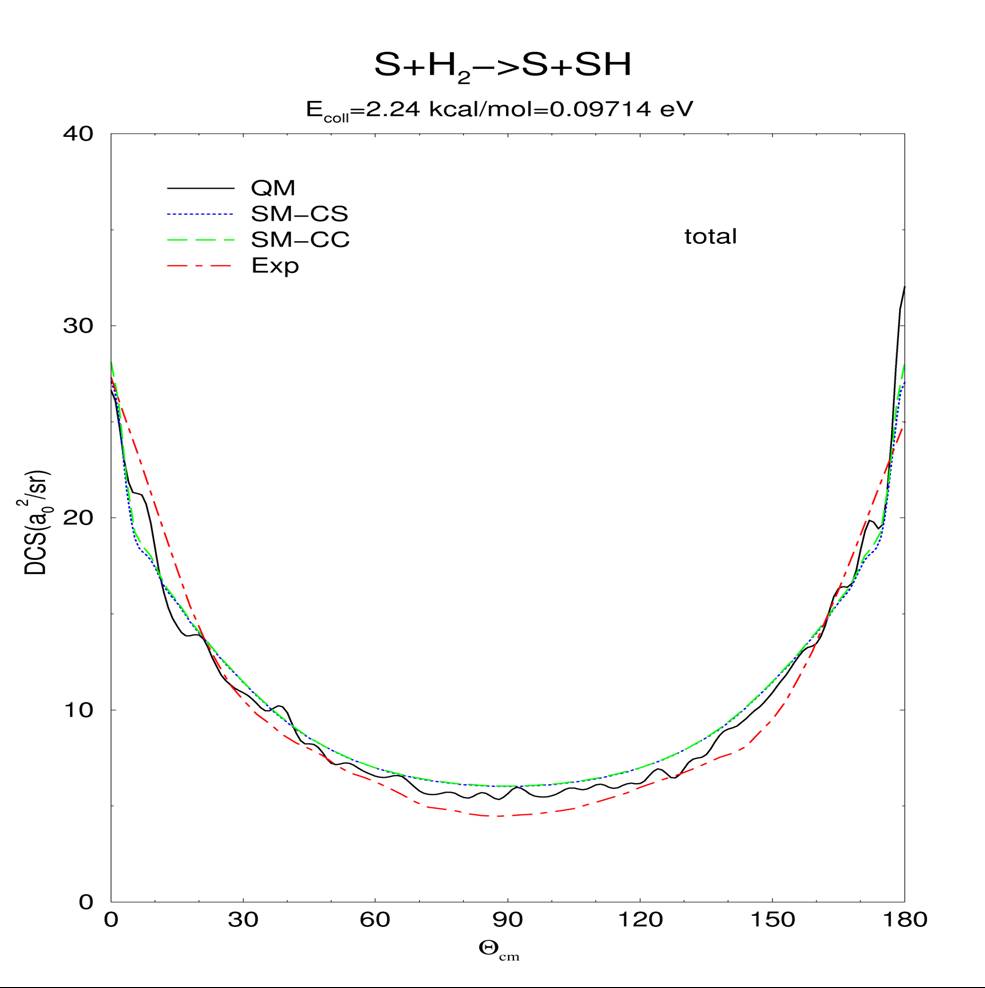
Atom-diatom insertion reactions where
the atom stays for a finite time close to the diatomic reactant forming
thus an intermediate complex proceed over deep potential energy wells.
This makes quantum theoretical calculations computationally very
demanding. Statistical models seem to work reasonably well to describe
the dynamics of such reactions. By means of a time independent version
of a statistical capture theory model, experimentally observables have
been satisfactorily reproduced. Comparisons of integral and differential
cross sections and rate constants with both experiment and exact
quantum results have revealed the feasibility of this approach to study
this kind of processes.
Time
dependent wave packet studies on A+BC reactions
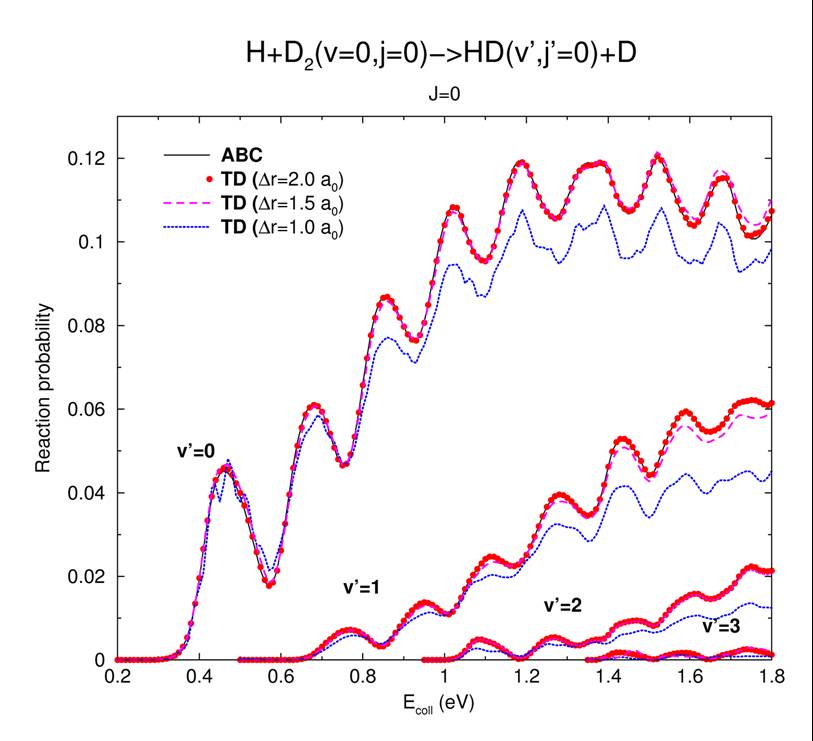
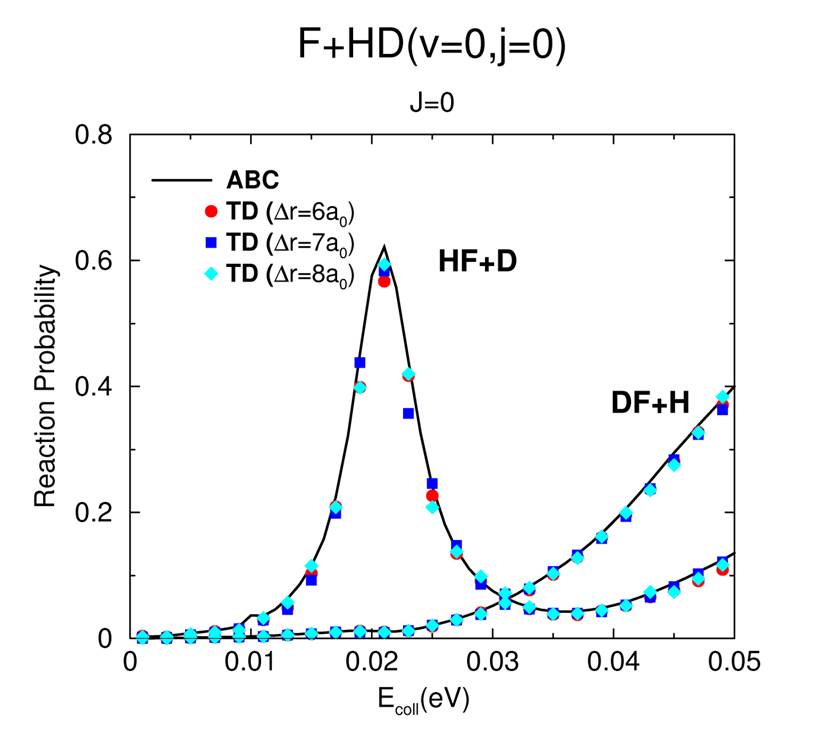
The study of atom-diatom reactions in
general is also tackled by means of a time dependent wave packet method
in combination with a recently derived transmission-free absorbing
potential. Initially state-selected reaction probabilities for J > 0
have been computed for reactions such as H+H2 (and isotopic
variants), H+O2, F+H2 (and isotopic variants) and
Li+HF. State-to-state processes have been also studied with a modified
version of the code.